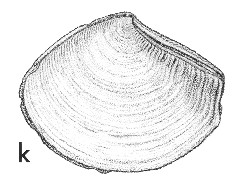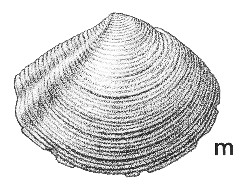
Revised descriptions of New Zealand Cenozoic Mollusca from Beu and Maxwell (1990)

 | Revised descriptions of New Zealand Cenozoic Mollusca from Beu and Maxwell (1990) | 
|
  (Pl. 41k): GS2773, T23/f6488, Mangatuatua Stream, near Pohangina, eastern Wanganui basin, Nukumaruan (GNS) |
  (Pl. 41m): GS2773, T23/f6488, Mangatuatua Stream, near Pohangina, eastern Wanganui basin, Nukumaruan (GNS) |
Beu & Maxwell (1990): Chapter 15; p. 317; pl. 41 k,m.
Synonymy: Myadora waitotarana Powell 1931, p. 95; Myadora striata stephaniae Carter 1972, p. 310; Myadora stephaniae, Beu & Maxwell 1990, p. 317, pl. 41k, m.
Classification: Myochamidae
Description: Moderately large for genus (28-37 mm long), low and elongate, with right valve weakly convex and left valve flat, and with highly convex anterior dorsal outline, opisthogyrous beaks, straight or weakly concave posterior dorsal outline, and evenly convex ventral outline; 2 prominent ridges below posterior dorsal margin in right valve. Sculpture of prominent, narrow, commarginal ridges on right valve, but little on left valve except near anterior and posterior ends. Interior nacreous, with smooth margin, 2 nearly equal adductor scars, small pallial sinus, and hinge that is smooth apart from small, prominent, triangular resilifer.
Comparison: Although it was proposed as a "subspecies" of the Nukumaruan to Recent species Myadora striata, Beu & Maxwell (1990, p. 317) considered M. stephaniae to be a distinct species. However, Beu (2006, p. 316-317) showed that M. stephaniae is part of the anagenetic evolution from M. waitotarana (which has a Waipipian holotype) to M. striata, and considered M. stephaniae to be a synonym of M. waitotarana. This species was kept distinct from M. striata because the anagenetic shape change and size increase through Pliocene time stopped at the end of Nukumaruan time, and M. striata has remained unchanged (static) since, but the significance of this as a species criterion is debatable. M. waitotarana is longer and much lower than M. striata, and has more prominent commarginal ridges. M. striata also reaches a larger maximum size (46 mm) than M. waitotarana. M. striata lives buried in sand in a few metres of water off quiet beaches (Morton 1977). All other New Zealand species of Myadora are much smaller than these two.
Distribution: Opoitian-Nukumaruan; Tangahoe Formation, mouth of Waihi Stream, Hawera, Waipipian (type of M. waitotarana); tributary of Te Ekaou Creek, near Pohangina, eastern Wanganui basin, late Mangapanian or early Nukumaruan (type of M. striata stephaniae); Kaawa Creek, SW Auckland (Opoitian); widespread but uncommon in near-shore sand facies in Wanganui basin, Hawke's Bay and Wairarapa.
Cite this publication as: "A.G. Beu and J.I. Raine (2009). Revised
descriptions of New Zealand Cenozoic Mollusca from Beu and Maxwell (1990). GNS
Science miscellaneous series no. 27."
© GNS Science, 2009
ISBN
978-0-478-19705-1
ISSN 1177-2441
(Included with a PDF facsimile file
copy of New Zealand Geological Survey Paleontological Bulletin 58 in CD version
from: Publications Officer, GNS Science, P.O. Box 30368 Lower Hutt, New
Zealand)